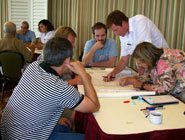
Benchmark proceeds with design for sustainable residential development
SANIBEL ISLAND, FL (May 29, 2009)
A collaborative agreement between Fort Myers-based Benchmark General Contractors, the Florida Community Design Center (FLCDC) and the University of Florida School of Architecture is the first step in the planning of a sustainable residential cluster of approximately 12 single-family homes on a 12-acre property along Periwinkle Way on Sanibel Island. The property was previously the site of the Old Schoolhouse Theater and the home of the Sanibel Landscape Company, the first landscape nursery on the island. Design plans are underway.

Charette Study photoThe mission is to create and optimize a sustainable, environmentally sensitive design that could become a model for future development of coastal communities in our region.
FLCDC, a non-profit research and outreach mission of UF’s School of Architecture, will submit for review a series of schematic designs for a residential enclave that integrates coastal ecologies, social connectivity, permaculture and sustainability as core principles of the neighborhood planning and architectural design.
Benchmark -partners Mark Anderson and Ron Rosen are donating an estimated five acres of the property to the Sanibel Captiva Conservation Foundation for the conservation and preservation of wetlands and protection of the Sanibel River corridor.
Martin Gold, Director of Architecture at UF and the Executive Director of the FLCDC, explains that this project will engage in the best practices for low impact development and sustainable community design. Experts will be consulted regarding stormwater strategies, storm resistant designs, building materials and energy efficient design where site resources – breezes, rainwater, solar radiation and natural vegetative systems – are optimized through integrated design.
Gold goes on to say that the clustering effect will result in a larger natural and undisturbed area that will host a rich variety of plant species and greater environmental opportunities for fish, turtles, butterflies, cattails and other wildlife. The higher number of plants will absorb hydrocarbons, thereby purifying stormwater runoff.
“Once we have finalized the community’s parameters, we will determine the best residential design based on LEED and Florida Green Building Coalition recommendations,” says Gold. “Some of these considerations are color durability, thermal shading and ventilation, day lighting, rainwater harvesting with cisterns, storm mitigation and resistant design, irrigation, and cooling efficiencies.”
Builders Anderson and Rosen say that many homeowners are shifting to the attitude that “less is more” and agree that energy efficient homes may be designed on a smaller scale.
“Many homebuyers are ready for a simpler lifestyle,” says Anderson. “Floor plans from 2,000 to 3,500 square feet are ample for most families, easier to cool, energy saving and the way of the future. There is an emerging awareness of transitional self-sustaining communities with the potential to function off the grid. The existing vegetation on the 12 acres is remarkable as a result of being a plant nursery site years ago.
“We are looking forward to this professional collaboration with UF and The FLCDC to work with us to fulfill our vision of a sustainable, eco-friendly neighborhood. Our goal is to protect and preserve the environment while creating a close-knit community that reminds homeowners of growing up in simpler times.”
FLCDC, a non-profit research and outreach mission of UF’s School of Architecture, will submit for review a series of schematic designs for a residential enclave that integrates coastal ecologies, social connectivity, permaculture and sustainability as core principles of the neighborhood planning and architectural design.
Benchmark -partners Mark Anderson and Ron Rosen are donating an estimated five acres of the property to the Sanibel Captiva Conservation Foundation for the conservation and preservation of wetlands and protection of the Sanibel River corridor.
Martin Gold, Director of Architecture at UF and the Executive Director of the FLCDC, explains that this project will engage in the best practices for low impact development and sustainable community design. Experts will be consulted regarding stormwater strategies, storm resistant designs, building materials and energy efficient design where site resources – breezes, rainwater, solar radiation and natural vegetative systems – are optimized through integrated design.
Gold goes on to say that the clustering effect will result in a larger natural and undisturbed area that will host a rich variety of plant species and greater environmental opportunities for fish, turtles, butterflies, cattails and other wildlife. The higher number of plants will absorb hydrocarbons, thereby purifying stormwater runoff.
“Once we have finalized the community’s parameters, we will determine the best residential design based on LEED and Florida Green Building Coalition recommendations,” says Gold. “Some of these considerations are color durability, thermal shading and ventilation, day lighting, rainwater harvesting with cisterns, storm mitigation and resistant design, irrigation, and cooling efficiencies.”
Builders Anderson and Rosen say that many homeowners are shifting to the attitude that “less is more” and agree that energy efficient homes may be designed on a smaller scale.
“Many homebuyers are ready for a simpler lifestyle,” says Anderson. “Floor plans from 2,000 to 3,500 square feet are ample for most families, easier to cool, energy saving and the way of the future. There is an emerging awareness of transitional self-sustaining communities with the potential to function off the grid. The existing vegetation on the 12 acres is remarkable as a result of being a plant nursery site years ago.
“We are looking forward to this professional collaboration with UF and The FLCDC to work with us to fulfill our vision of a sustainable, eco-friendly neighborhood. Our goal is to protect and preserve the environment while creating a close-knit community that reminds homeowners of growing up in simpler times.”
MORE ABOUT BENCHMARK GENERAL CONTRACTORS
Founded in 1984, Benchmark General Contractors is committed to projects that are sustainable and environmentally sensitive. The firm’s newest project is Sea Glass of Sanibel, a prototype sustainable community of 12 single-family homes in collaboration with the University of Florida’s Community Design Center. Benchmark has completed hundreds of commercial and residential properties, as well as restoration, renovation and remodeling projects. Their mission is to build upon their philosophy of exceptional service, creating quality buildings in a timely fashion. Benchmark serves Fort Myers, Naples, Sanibel and Captiva Islands, Cape Coral, Bonita Springs and all of Southwest Florida.